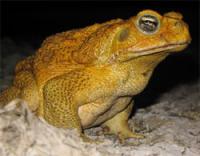
Australian cane toad (Chaunus [Bufo] marinus) Why do some invasive species expand rapidly in a new environment while others do not" Scientists from the United States and Australia are beginning to make headway on this question after analyzing how fast cane toads invaded different regions of Australia.
Using over 70 years of data on toad presences collected since their introduction, researchers discovered that cane toads invaded different regions of Australia at dramatically divergent rates. These variable invasion rates appear to be e explained not only by environmental features that facilitate toad movement, but also by the evolution of higher movement rates. Natural selection might cause the evolution of increased movement rates in individuals at the edge of a species' range because the first individuals to arrive can monopolize the best habitats and exclude later arrivals and thus gain an advantage.
"The worrying message from this research is that if control efforts fail and an invasive species spreads across a sufficiently large area," says Mark Urban, "then it may be able to invade a broader region than expected because it has adapted to move across greater distances at the edge of its range."
He adds, "Understanding how environmental and genetic variation affects the movement rates of invading populations will generate better predictions about when an introduced species will arrive in a sensitive ecosystem. Our hope is that this information will help control the expansion of introduced species more effectively in the future."
This research has important implications for the global conservation of endangered species, many of which are threatened by the expanding ranges of introduced plants and animals.
Source : University of Chicago Press Journals
 Print Article
Print Article Mail to a Friend
Mail to a Friend
